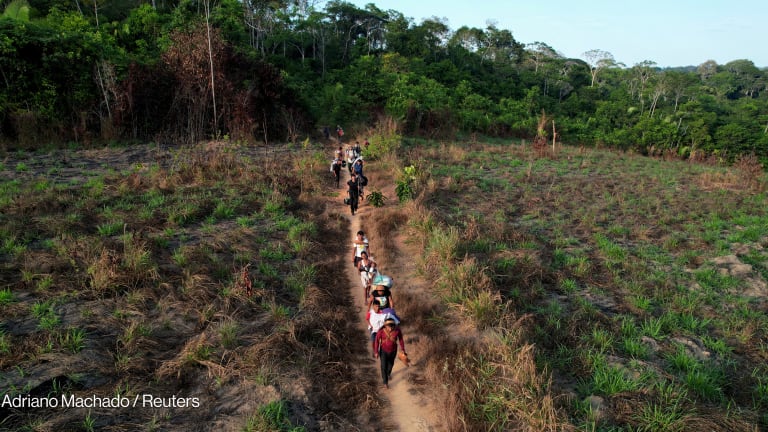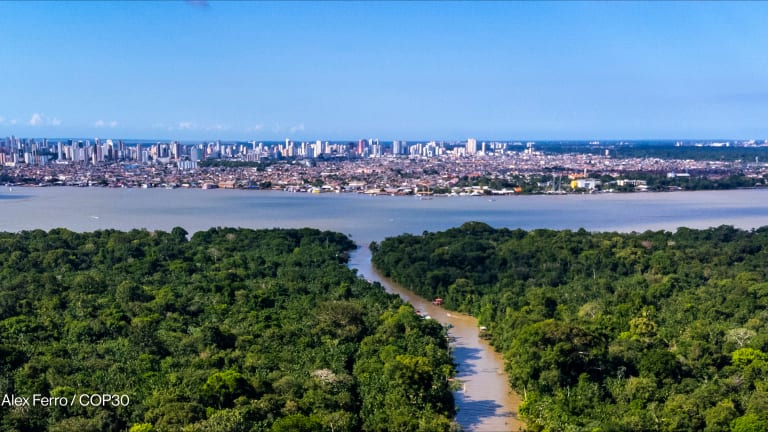
Amid a climate crisis and COVID-19, water experts and Indigenous leaders called for the sector to learn from and adopt Indigenous approaches to managing water.
According to the United Nations Environment Programme, Indigenous peoples and local communities manage, own, or occupy around 25% of the world’s land area. In those places, nature is thought to be degrading at a slower rate amid climate change.
All too often, “dominant cultures” exhaust the earth and its resources as if it’s something consumable, putting profit first, said Jennifer Veilleux, research affiliate at the Florida International University, in a panel during last week’s World Water Week.
This has led to issues of water scarcity. According to UN-Water, 2.3 billion people live in water-stressed countries and, as a result of climate-induced extreme weather events, over 20% of the world’s basins have recently flooded or dried up.
“When flood plains are harvested and irrigators are allowed to take too much water, the rivers run dry,” said Virginia Robertson, secretary of Dharriwaa Elders Group — an Aboriginal cultural organization based in Australia — adding that the cotton industry had “sucked up” water from the Murray-Darling basin in southeast Australia.
Opinion: To safeguard the planet, recognize communities’ territorial rights to land — and water
How can governments accelerate legal recognition of communities’ territorial rights to both land and freshwater, including protections for the specific rights of community women?
Western engineering and science oversimplifies and doesn’t have a place in water systems going forward, Veilleux said. “Being people who work in water, we have an opportunity to build those relationships and take a different approach and learn a different way,” she added.
“Indigenous knowledge is key to addressing many of the complex challenges of climate change and its impact on wider natural ecosystems like forests, rivers, mountains, and coasts,” Åsa Heijne, counselor program manager of the environment and climate at the Embassy of Sweden in Thailand, said during a separate panel on integrating Indigenous knowledge into the design of nature-based solutions.
“Greed is not acceptable to us. This is one of the main things we were taught by our elders, our people,” Robertson said. “If you look after the country, it’s my belief the country will look after you.”
According to UNEP, an Indigenous approach looks to maintain balance in the environment so that access to water, fertile soil, food, shelter, and medicine is viable. For example, living root bridges made from the ficus tree in India allow for increased access to resources, and the construction of floating gardens by farmers in Bangladesh means vegetables can grow even as water levels change.
“Indigenous knowledge is key to addressing many of the complex challenges of climate change and its impact on wider natural ecosystems like forests, rivers, mountains, and coasts.”
— Åsa Heijne, counselor program manager of the environment and climate, Embassy of Sweden in ThailandIn India and Bangladesh, riparian communities along the Ganga, Brahmaputra, and Meghna river basins have long implemented nature-based solutions and traditional strategies to tackle water security, floods, and riverbank erosion.
“This is the changing narrative where nature is more being looked at as a solution to the different problems and, in this discourse, Indigenous people are at the center,” Vishwa Ranjan Sinha, program officer of water and wetlands at the International Union for Conservation of Nature in South Asia, told attendees. “Indigenous knowledge promotes sustainability.”
Veilleux urged World Water Week participants to build relationships with Indigenous communities in the areas where they work. “There’s so much to be shared and learned and we have a tendency, with our Western education, to think we know more than those on the ground and it’s not true,” she said.
Nuzhat Nueary, project officer at Oxfam in Bangladesh, explained that Oxfam had implemented an Indigenous practice — the use of bandals, which are structures made of bamboo and divert river flow to the center to stabilize the banks — to tackle riverbank erosion. Like most Indigenous knowledge, Nueary said this practice was not well-documented so Oxfam began counselling communities and taking an inclusive water governance approach to implementation.
In its Standard on Indigenous Peoples, IUCN states that traditional ecological knowledge be “recognized, respected, and protected,” and calls for Indigenous peoples to be “consulted in a culturally appropriate way and be active and effective participants in decision-making processes relevant to them.”
Visit the WASH Works series for more coverage on water, sanitation, and hygiene — and importantly, how WASH efforts intersect with other development challenges. You can join the conversation using the hashtag #WASHWorks.









